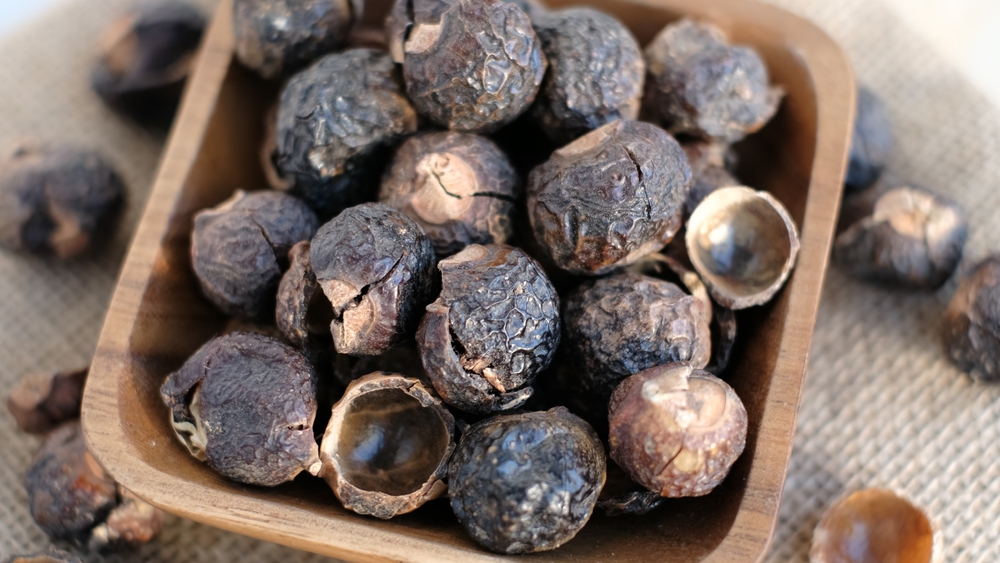
The basic recipe for making soap has been the same for thousands of years.
Combining plant or animal fats with an alkali causes a chemical transformation, a process known as saponification.
Saponification is what gives soap its sudsy cleaning action, bonding with oils and grime so they can be rinsed away.
Soaps processed in this manner mimics the naturally occurring surfactants found broadly throughout the plant kingdom.

Saponins are surface-active compounds with a similar chemical structure as soap, typically occurring in the tissues, roots, flowers, fruit, or seeds in more than 100 plant families.
When wetted and agitated, saponin-rich plants create a nice foamy lather that can be used as a gentle cleanser.
With no need for processing, equipment, or ingredients, growing soap is the easiest way to obtain your own soap supply. This is especially valuable when there is a run on soaps in the stores or you would like to become more self-reliant.
Whilesoap nutsare among the better recognized saponin-rich plants, there are plenty of other sudsy cultivars to grow or forage for soap.

1. Wavyleaf Soap Plant (Chlorogalum pomeridianum)

Wavyleaf soap plant, also known as soap root or amole, is a low growing perennial native to California and Oregon.
Named for its long wavy edged leaves that emerge in a rosette from a large underground bulb, it bears star-like flowers on a tall stalk that can reach 6 feet in height. These flowers bloom only once per season and only at night.
How to Harvest for Soap

The bulb of wavyleaf soap plant is where the saponins are found. It is about the size of a fist and is covered in dense brown fibers.
Remove the fibers carefully with a knife to expose the white, inner “heart”. Crush up the bulb, add some water, and agitate to produce a nice soapy foam.
To avoid killing the entire plant, cut the bulb in half lengthwise, making sure to leave some of the roots intact. Replant the one half and keep the other for soap.
To store for later use, dry the bulb in a cool and dark place.
Wavyleaf soap plant is excellent as a laundry soap (especially for delicates), dish detergent, bath soap, and shampoo.
2. Soapwort (Saponaria officinalis)

Producing orb-like clusters composed of numerous five-petal flowers in pink or white, soapwort is a pretty specimen that blooms from July to September.
Individual flowers are sweetly fragrant and stay open for only three days during the evening.
A European native, soapwort has been naturalized throughout much of North America. It is hardy in zones 3 to 8 and grows best in poor, sandy soil.
How to Harvest for Soap

The leaves, flowers, and roots of the soapwort plant can be used as soap.
Chop up these parts of the plant and place in a pot of boiling water. Stir well to create a soapy lather. Strain out the plant debris and allow it to cool before using.
This lathery liquid is a mild cleanser that has been traditionally used to clean fabrics and is especially good for delicate wool fibers. It also may be used as a gentle facial cleanser and treatment for dry skin.

3. Mountain Lilac (Ceanothus spp.)

TheCeanothusgenus makes up some 60 species of small trees or shrubs in the buckhorn family. They can be found throughout North America in deserts, shrub land, and mountainsides, but are most abundant in the West.
Providing colorful blooms and a lovely fragrance in the wilds, many species ofCeanothusmay be used as soap.
The easiest way to determine whether the plant is rich in saponins is to take a handful of blossoms, add water, and rub. If it is mountain lilac, it will produce a good lather with a nice aroma.
How to Harvest for Soap
Mountain lilac blooms in dense clusters of white, purple, or blue in early spring. Once the flowers drop in early summer, tiny green fruits develop.

Both the flowers and fruit of mountain lilac will create suds with water and agitation.
存储供以后使用,干鲜花和水果a cool, dark space. When ready to use, grind them up into a fine powder and add water.
4. Soapweed Yucca (Yucca glauca)

A plant with many uses, soapweed yucca is a drought-tolerant species that ranges throughout central North America, from the Canadian prairies south to Texas.
It grows in spiky clumps, about 3 feet wide, with pale green dagger-like leaves. Each summer, it flowers with a 4-foot tall stalk bearing numerous cream colored bell-shaped blooms.
In addition to its soapy properties, the stiff leaves of soapweed yucca have been used in weaving for baskets, mats, ropes, and sandals.
How to Harvest for Soap
While the rootstock of soapweed yucca is the most abundant in saponins, the spiky leaves are also quite useful for making soap and shampoo.
To harvest the leaves, snip off the leave at the base of the plant. To avoid jabbing yourself with the pointy end, cut off the tip as well.
Strip leaves down the length from tip to base until you have many thin strands. Add water and rub between your hands to generate a sudsy lather.
Similarly, harvest the “heart” of the plant by pulling it from the ground. Slice off the leaves and roots and set aside, leaving the base of the plant.
To produce soap, simply crush up into a pulp and add water.
Here’s a helpful video demonstrating how to harvest yucca for soap both ways.
5. Horse Chestnut (Aesculus hippocastanum)

Horse chestnut isn’t a true chestnut but a member of the soapberry family. It bears inedible seeds that are highly concentrated in saponins.
Native to the Balkans, it has been introduced to many temperate parts of the globe and grows well in hardiness zones 3 to 8.
Horse chestnut trees reach a height of 75 feet with a 65 foot spread, bearing showy white upright floral clusters dotted in pink or red.
These turn into shiny brown chestnuts that are covered in a spiky green husk.
How to Harvest for Soap

Harvest horse chestnut seeds by first removing the green husk.
Soak seeds overnight to soften them before chopping or crushing them up with spoon. Add hot water and strain out the seed bits once it has cooled.
You can also store horse chestnuts for later use by grinding them up in the blender and air or oven-drying until they are completely dehydrated.
当准备肥皂溶液,添加一个tablespoon or two per cup of hot water and stir. Strain before using for cleaning, laundry, soap, and shampoo.
6. Bracken Fern (Pteridium aquilinum)

Found in every state in the US except Nebraska, bracken fern is a common sight in forests and woodland areas.
Bracken fern is a vigorous grower, emerging from its rootstock in spring with numerous fiddleheads that eventually mature into expansive fronds.

A non fussy plant, bracken fern grows well in full sun or partial shade and prefers sandy and acidic soil conditions. It is hardy in zones 3 to 10.
How to Harvest for Soap
The creeping underground rhizomes of bracken fern are plentiful in saponins. These tuberous stems are covered in black root hairs and can reach 20 feet or more in established plants.
Dig up and harvest a portion of the rhizome and cut into smaller pieces. Boil in a pot of water and stir to make a sudsy cleaning solution. Strain and allow to cool before using.
7. Baby’s Breath (Gypsophila paniculata)

Best known as a filler for floral arrangements, baby’s breath is actually a lovely mounding bushy plant in its natural state, blooming profusely with teeny tiny white flowers in summer.
哈代在区3 - 9中,它的花朵将持续throughout the entire season, from April to August.
With a height and spread of 2 to 3 feet, baby’s breath grows best in full sun in alkaline, well drained soils.
How to Harvest for Soap
The roots of the baby’s breath plant can be rendered into soap by boiling them in water.
Stir and agitate until foam is produced, then strain out the roots and allow the mixture to cool.
8. Wild Mock Orange (Philadelphus lewisii)

A flowering shrub native to the western parts of North America, wild mock orange is so named due to the lovely citrusy scent of its flowers that produce no oranges.
Wild mock orange may reach up to 12 feet in height, with long arching branches and simple oval leaves.
Clusters of 4-petal white flowers bloom from late spring to early summer, emitting a strong orangey fragrance with just a hint of pineapple.
Adaptable to a range of soils in full to part sun, wild mock orange is hardy in zones 3 to 9.
How to Harvest for Soap
The leaves, flowers, and bark of wild mock orange are rich in saponins.
Harvest these parts and place in a jar of cool water and shake. Once a soapy mixture is formed, strain out the plant bits and use as a mild all-purpose cleanser.

